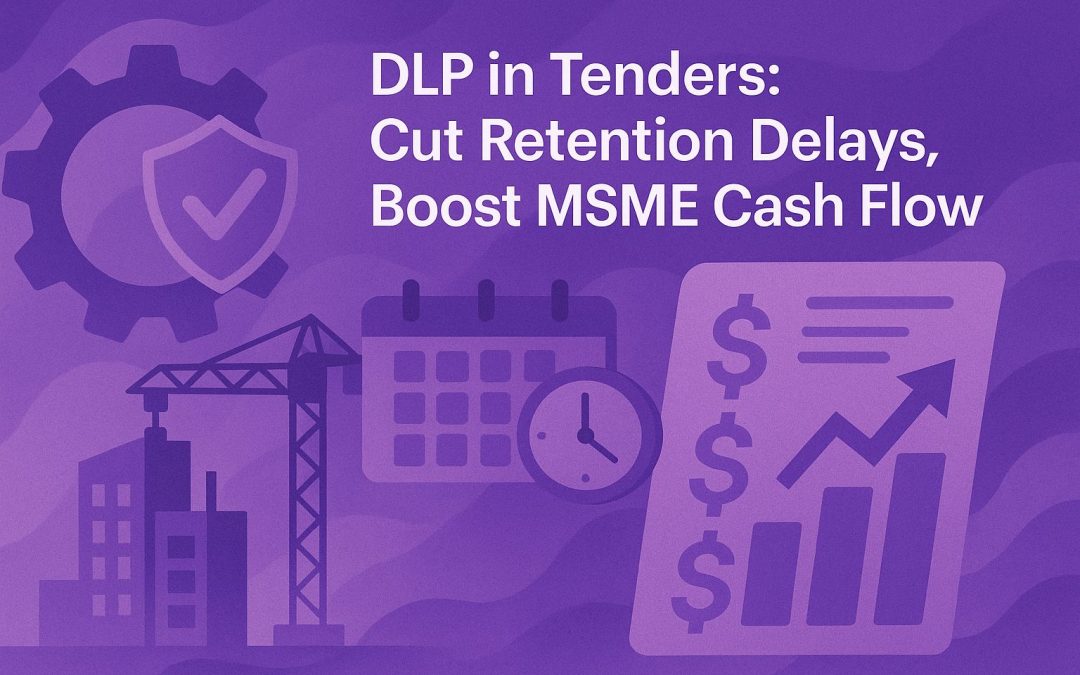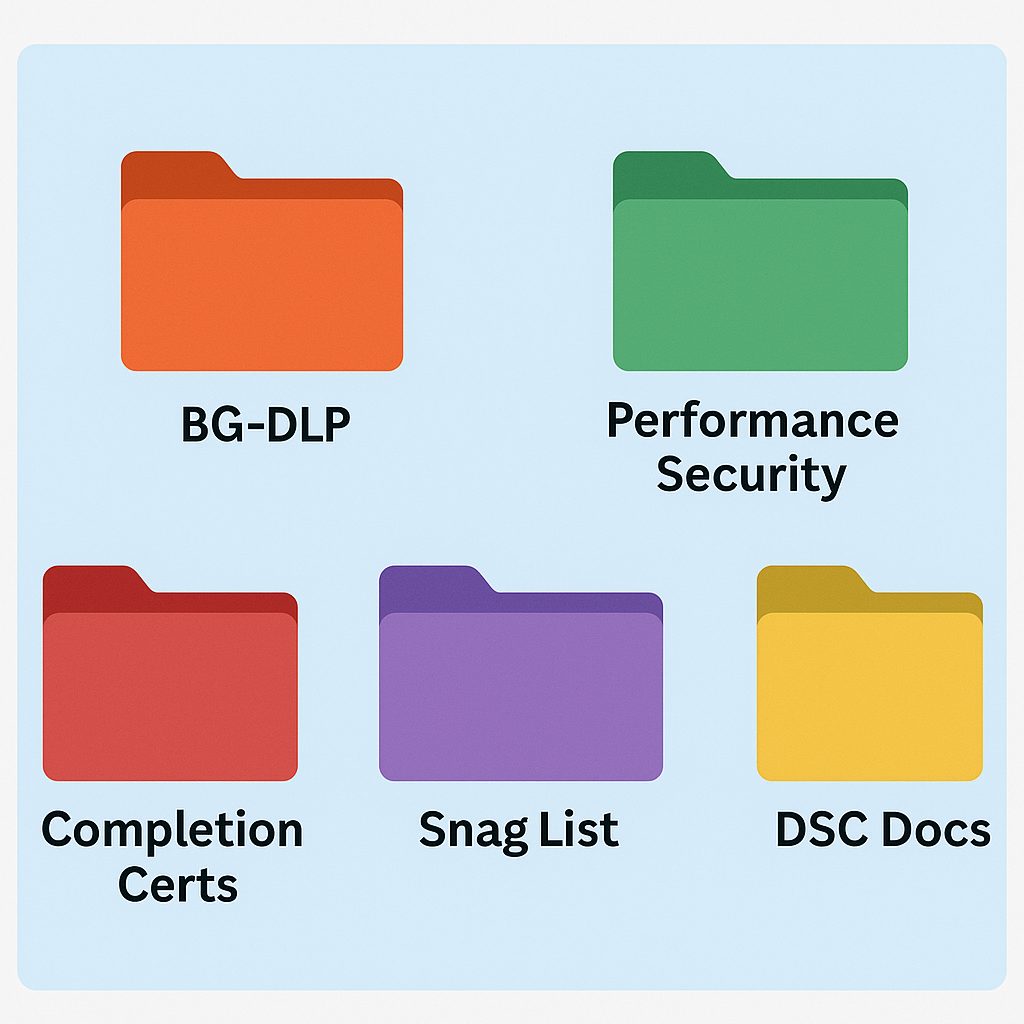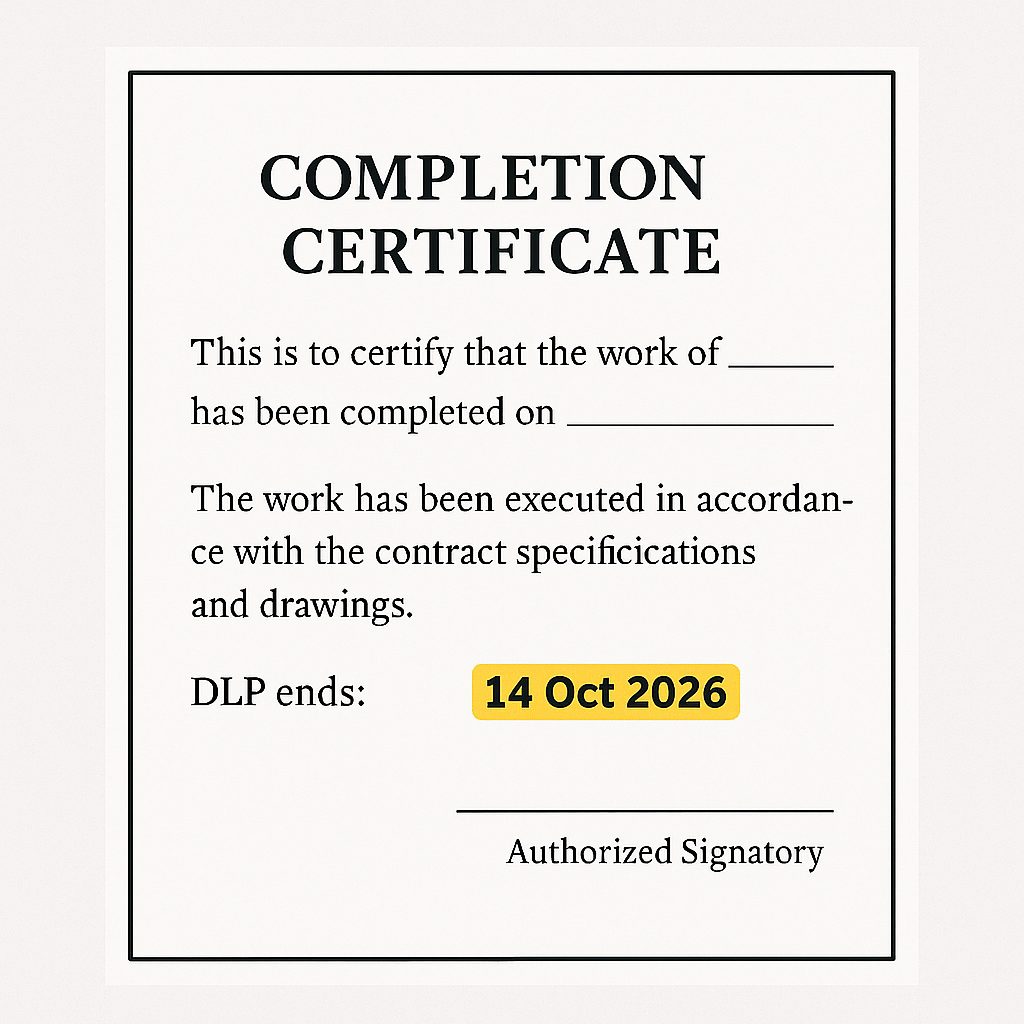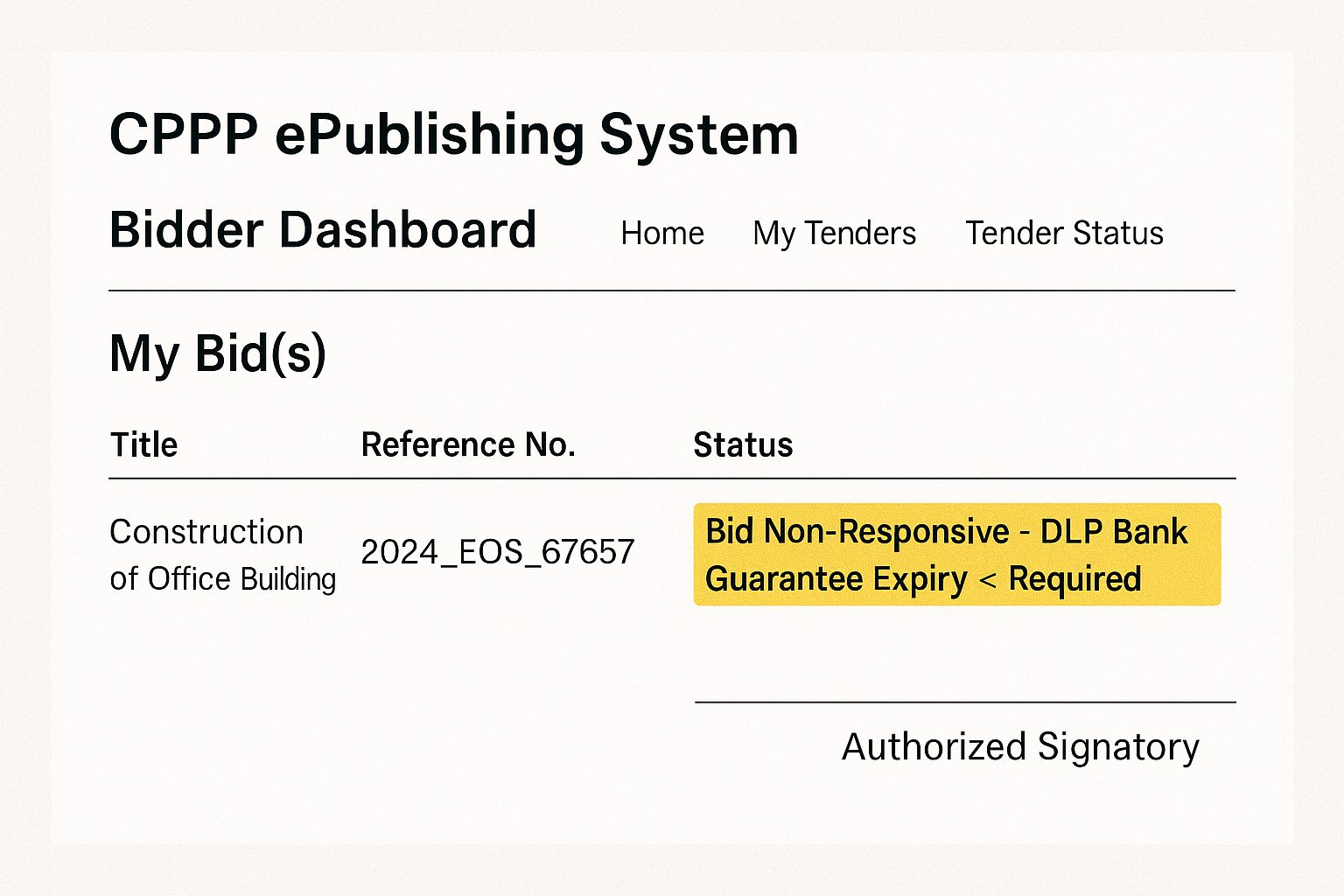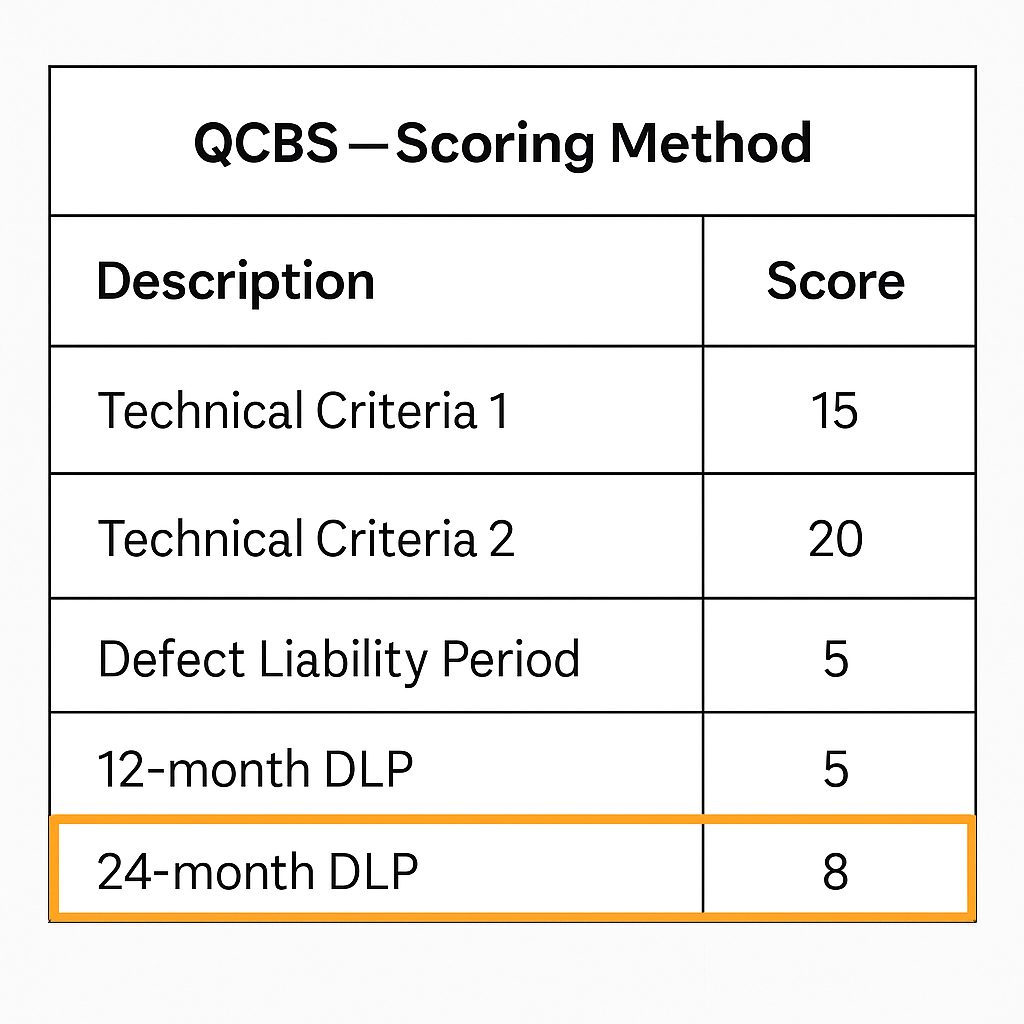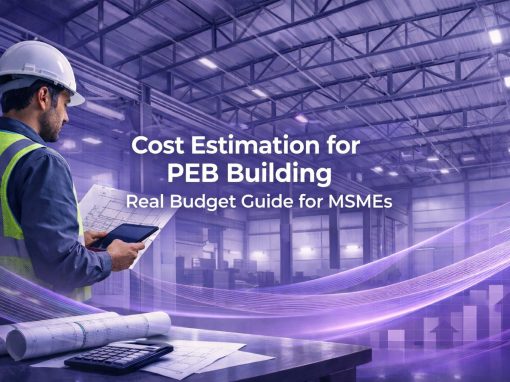Table of Contents
The DLP which stands for Defect Liability Period (DLP) — sometimes called the contractor liability period — is the span after project hand-over when you must fix any faults at your own cost. In Indian public works, the DLP usually runs 12 to 24 months, yet EPC roads can stretch to ten years. Treat the DLP clause in contracts as a silent clock: once it starts, your final 5–10 % payment (retention money) stays locked until the buyer signs a DLP clearance certificate. Miss a deadline, and you chase cash for months.
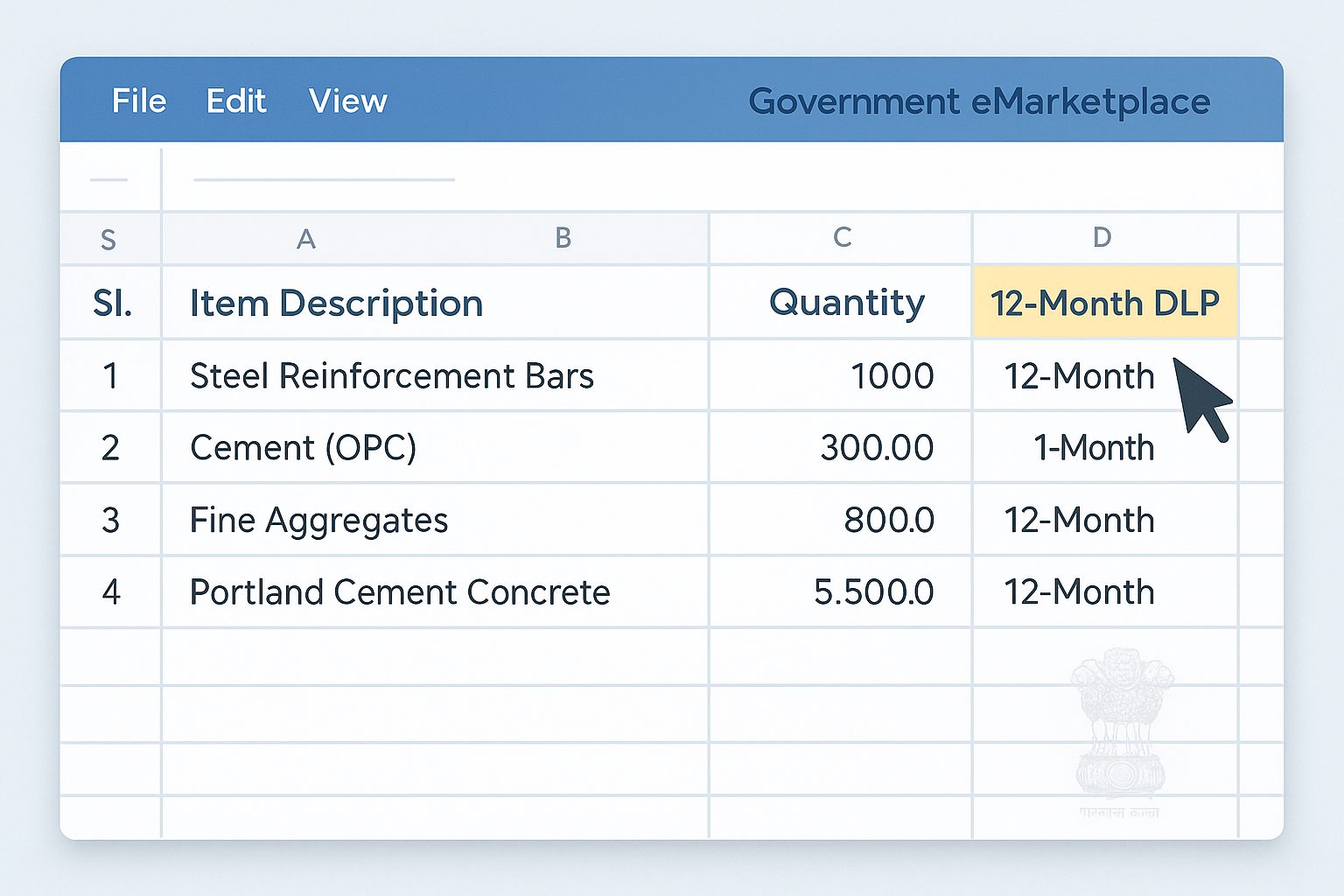
Why do ministries insist on it? Simple — they need assurance the asset lives up to specs long after inauguration day. That means you’ll lodge a bank guarantee for DLP or let the buyer hold retention money. For micro units, that tie-up can cripple working capital. Plan for it upfront: price in periodic site visits, snag-list fixes, and a small fund for material replacements.
Here’s what new MSMEs often miss on GeM: the portal timestamps the DLP the moment you generate the Works Contract. If you delay supply by even a week, your warranty and DLP difference widens, stretching liability. State PWD portals raise the stakes further by demanding a separate DLP guarantee on top of performance security — effectively double collateral unless you negotiate consolidation.
A Jaipur-based electrical-panel manufacturer learned this the hard way. Their CPWD bid won, but the evaluator spotted an expired completion certificate from a past job. Tender rules flagged the document, pushed them into clarification, and held back ₹18 lakh in retention for an extra six months. A quick renewal, uploaded correctly, would have freed that money sooner. Moral? Technical bid documentation must show live experience within the active DLP window — no stale proofs allowed.
Portal-Specific Rules: How GeM, CPPP & State PWD Sites Handle the DLP
The public-procurement landscape looks uniform at first glance, yet each portal hides its own DLP landmines. Skim the tender notice and you miss them; drill into annexures and the fine print jumps out.
GeM Works Contracts — auto-clocked DLP:
GeM drops a default gem works contract DLP of 12 months into every BoQ. You can’t delete it, but you can request partial retention release after six months if all snag items read “closed.”
Upload the joint inspection certificate using the portal’s “Completion / DLP Docs” slot — wrong slot, and the evaluator never sees it. GeM also links your digital signature for tender to the DLP timeline; rotate a new DSC mid-project and the system may flag “signature mismatch,” freezing payments until re-validation.
CPPP / eProcure — file-naming traps
CPPP’s validator checks both extension and sequence. The DLP warranty must sit as 07_DLP_Warranty.pdf in the technical bid folder. Rename it as “warrantyfinal.pdf,” and the parser spits out “non-responsive,” pushing you into manual clarification. Many MSMEs lose points under QCBS evaluation criteria simply because the committee never opens the mis-tagged file. Always run CPPP’s pre-bid checklist: size under 10 MB, PDF/A standard, and a live DSC seal on every page.
State PWD Portals — double guarantee alert
States like Madhya Pradesh and Rajasthan mandate a separate state pwd tender DLP bank guarantee, often 5 % of contract value, valid for the full liability horizon. Forget to upload that guarantee or set an early expiry date, and the bid auto-rejects at financial-opening stage. Some savvy vendors merge performance security and DLP into one instrument — allowed under recent MoF circulars — but you must cite the order and tag the file “Consolidated_BG_DLP_PS.pdf.”
Tender Document Sequencing matters
GeM reads metadata; CPPP reads filenames; state sites read cover numbers. Map each DLP proof to the correct cover or slot before the countdown starts. Skip that, and the portal rejects your bid before a human evaluator even logs in.
Avoid this common rejection trigger: A Kanpur-based HVAC startup uploaded its DLP guarantee as “BG.pdf” in CPPP Cover-2. The parser flagged “missing BG,” and the bid never reached technical scoring — despite perfect pricing. Tender portals forgive nothing, so sequence every DLP document exactly as the manual prescribes.
Building a Compliant DLP Document Pack
Putting together the right DLP paperwork feels tedious, yet it saves weeks of bid clarifications later. Treat the pack like a checklist: if one sheet goes missing, the portal’s parser slams the gate before evaluators read your price.
Start with the money instrument.
Decide early whether you’ll lodge a bank guarantee for DLP or let the buyer hold retention money. Micro units often prefer a guarantee over a 10 % cash lock-up. Use the buyer’s template, insert exact validity dates (DLP end + 28 days buffer), and get two authorised signatories. Upload it as a single, DSC-sealed PDF — multi-files break the portal viewer.
Layer in experience proof.
Most works tenders demand a live completion certificate showing similar value within the contractor liability period. If your biggest job closed five years ago, it’s already outside a 24-month DLP window — evaluators will mark “non-responsive.” Renew it with the client engineer or attach an ongoing defect rectification process log to prove you’re still liable.
Disclaimer: Images shown are for illustration only and do not represent official tender portals or documents.
Sequence the technical annexures.
GeM calls them Tabs, CPPP calls them Covers, state sites call them Envelopes — the rule stays the same: put technical bid documentation (BG, certificates, snag list) before the financial quote. Any swap invites an instant portal error. Label files “01_BG_DLP.pdf,” “02_TurnoverCert.pdf,” and so on. Skipping numbers confuses CPPP’s checksum.
Lock it with a fresh DSC.
Nothing derails submissions faster than a revoked token. Check the digital signature for tender one week ahead; renew drivers, synchronise system time, and clear browser cache. A Pune-based façade installer ignored the warning pop-up, signed with an expired DSC, and watched the CPPP page freeze at 98 % — bid lost, lesson learned.
Finally, keep a bid rejection checklist on your desk: BG format correct, DSC valid, certificates within DLP range, PDFs under 10 MB, filenames sequenced. Tick every box before you hit “Submit.” This 15-minute ritual often decides whether your quote even reaches the price table.
Avoiding the Top DLP-Related Bid Rejections
A tender committee usually needs barely ten seconds to flag a DLP mismatch. Their portal dashboard flashes red, and your bid slides straight to the rejection pile. The causes look trivial on paper, yet they surface week after week — especially for first-time MSME bidders.
Disclaimer: Images shown are for illustration only and do not represent official tender portals or documents.
Expiry gaps derail guarantees.
Many vendors key in the DLP end date but forget the mandatory buffer (typically 28 days). A Lucknow civil contractor submitted a ₹14 lakh bank guarantee for DLP expiring the very day the liability ended; CPPP flagged “validity shortfall,” and the bid never opened. Always add the buffer — it’s literally one calendar field.
Wrong cover, lost document.
Portals parse filenames first, human eyes later. Upload your joint inspection certificate in the financial envelope and the system insists it’s “missing,” even though the evaluator can see it. Stick to the sequence you set in Section 3: BG first, certificates next, price last.
Stale completion proofs.
Evaluators cross-check that the referenced job is still inside its own defect liability period in tenders. If your certificate shows a DLP that lapsed eight months ago, the portal’s checklist lights up. Renew the document or append the current defect rectification process log — a two-line engineer’s note can save a ₹2 crore quote.
Inconsistent warranty wording.
Some departments score extra under qcbs evaluation criteria for offering an “extended DLP.” If you promise 24 months in the tech bid but your BG reads 12 months, you’ll fail technical compliance. Mirror the dates and language exactly across every file; copy-paste when in doubt.
Remember: bid rejection reasons rarely relate to price. They hinge on clerical slips that the portal can quantify. Pre-submission, run a hard-stop checklist: BG validity plus buffer, file in correct cover, DLP dates identical across all docs, DSC seal visible. Spend the extra 20 minutes now — or lose weeks chasing a re-tender later.
Turning the DLP into a Competitive Edge
Most bidders treat the defect liability period in tenders as a drag on cash. Flip that mindset. A smart, well-costed extended warranty offer often nudges your score past bigger rivals in a QCBS race.
Take the Hyderabad-based elevator MSME that added a six-month extension to the default GeM works contract DLP. The committee’s matrix awarded three extra technical points, enough to outrank a larger PSU on price parity. They priced the extension at just 0.8 % of project value — well below the weighted benefit — because they already stock spare drive belts. Tender pricing strategy: audit your maintenance inventory, then quote an extension only where the marginal cost stays low.
Leverage the Udyam exemption rules to protect liquidity. With an EMD waiver for MSMEs in hand, you can afford a slightly larger bank guarantee for DLP without straining cash. Pair that with a consolidated “Performance + DLP” bond (per MoF circular) to avoid double collateral.
Plan the close-out early. Schedule joint inspections at months 3, 6, 9, and 11; log every snag fix in a digital sheet. When the clock hits month 12, your DLP clearance certificate is ready for upload the same week. Retention releases within 15 days instead of the usual quarter — a quiet win few vendors exploit.
A quick recap? Offer longer coverage where spares are cheap, price it surgically, use Udyam to ease the guarantee load, and time site visits so the final payment hits on cue. That’s how a liability turns into a lever.
Conclusion
The DLP sits at the centre of every public-works contract, yet most first-time bidders treat it as after-sales fine print. Flip that script. When you build a document pack that pairs a bank guarantee with buffered validity, label every PDF for the exact portal slot, and keep your completion certificates live, evaluators see a vendor who manages risk—not one who creates it. The payoff arrives in real cash: retention money releases on time, and your bid survives the parser’s first swipe, moving straight to price scoring.
Push further and turn that liability into leverage. Scope the true cost of an extra six- or twelve-month warranty, use your Udyam status to run lean on EMD, and cite the MoF circular to merge performance security with the DLP bond. Layer in scheduled joint inspections so the DLP clearance certificate lands in your inbox the week the clock stops. Executed together, these steps convert a contractual obligation into a competitive wedge that even larger rivals struggle to match.
Looking for the right government tenders for your business?
Tata nexarc helps MSMEs, manufacturers, and service providers find relevant government tenders across India. Discover tenders by location, category, or department, track deadlines, and get notified on time — with complete support to help you apply confidently.
FAQs
What is the Defect Liability Period in a government tender?
Can the Defect Liability Period be negotiated before the contract is signed?
Is the Defect Liability Period the same for goods and civil works?
Who is responsible for issuing the DLP clearance certificate?
What happens if the DLP bank guarantee expires before the liability period ends?
Can a Micro, Small or Medium Enterprise use one BG for both performance and DLP?
What if a defect is found after the Defect Liability Period ends?
Is DLP retention money automatically released at the end of the period?
Can the Defect Liability Period be paused due to force majeure events?
Do first-time MSME bidders need DLP-specific insurance coverage?
Ananya Mittal blends a background in data science with a passion for writing, contributing to Tata Nexarc’s efforts in creating insightful, data-informed content for MSMEs. Her work focuses on exploring sector-specific challenges and opportunities across procurement, logistics, and business strategy. She is also involved in leveraging analytics to strengthen content performance and deliver actionable insights to India's growing B2B ecosystem.
